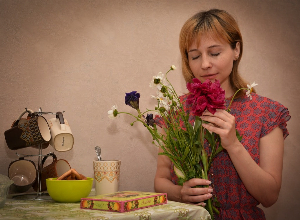Why do we cry?
Published Dec 4, 2022 • By Candice Salomé
Sometimes, when we feel too emotional, our vision starts to get blurry and tears begin to flow. Whether they are tears of joy, sadness, anger or pain, the mechanism is the same, but there are also other types of tears that are not related to emotions.
So what are the mechanisms that provoke tears? What are the benefits of tears? Are we all equal when it comes to tears?
We explain it all in our article!

What are tears?
Deep sadness, a touching romantic film, extreme pain: many situations can make us cry.
Although we are not the only living beings to be able to produce tears, humans are the only ones who can actually cry. Indeed, in case of fear or pain, animals will bark, bellow or roar, whereas humans will cry.
More specifically, there are three types of tears that do not have the same chemical composition. However, they do have certain components in common:
- Sodium chloride,
- Glucose,
- Lipids,
- Urea.
Depending on their nature, tears are also loaded with other compounds:
- Basal tears: they bathe your eyes as soon as you blink in order to hydrate and nourish the cornea. They are controlled by hormones. Indeed, it has been observed that with age, and particularly in women after the menopause, basal secretions are less well regulated and the glands located in the eyelid deteriorate. This leads to dry eyes. These tears do not, therefore, make us actually cry,
- Reflex or irritant tears: these occur when you cut an onion or get sand or dust in your eyes, for example. They occur when the surface of the eye is damaged by an external object. They are directly related to the lacrimal gland which is located in the upper outer corner of the eye socket. These are loaded with antibodies and enzymes, designed to repair, sterilize and possibly remove dust or bacteria from the eye - creating dirt at the corners of the eye.
- Tears of emotion, or actual crying, can only be produced by humans. This is a genetic mutation resulting from evolution.
So why do we cry?
When an emotion such as fear, sadness, joy - or even after an orgasm - appears, a neuronal connection is made between the areas of the brain responsible for managing these emotions and the lacrimal glands. Tears are then secreted, notably to relieve the individual, allowing them to evacuate emotions that they are not always able to verbalize.
Tears, appearing at the peak of an emotional upheaval, allow the body to calm down. We can describe it as an "emotional reset".
Indeed, the composition of tears, loaded with proteins and hormones, induces a feeling of well-being, provokes stress reduction and helps us to calm down. The same happens when we laugh a lot. Thus, tears have a liberating function. After crying, one feels lighter, as if a weight has been lifted.
Tears also have a social function. Tears send a message that is easily perceived by another person. Crying promotes empathy, cooperation and bonding.
Are we all equal when it comes to tears?
In New Zealand, among the Maori, when two friends meet after a long separation, they sit down and cry together. Culture takes precedence over emotion; they cry primarily to honor the memory of those who have died during the separation.
Thus, crying also has a cultural function where emotion is not necessarily what causes the tears.
At bar mitzvas or graduations, among Jews, tears are a sign of recognition of the new roles that young people are going to occupy in society.
In more individualistic societies, such as in Anglo-Saxon countries, emotion tends to remain private and restraint is often encouraged.
Furthermore, American researchers have tried to measure the quantity and frequency of crying by asking a panel of individuals to keep a diary. Men were more reluctant to respond than women, and most individuals were unsure what to consider as "real tears". For example, many wondered if tears that were shed while watching a sad film were "real".
Despite this, a number of findings emerged: age would have an impact on tears. Indeed, their production tends to drop by 40% starting from the age of 65 and by 70% from the age of 80. People tend to cry mostly between 7pm and 10pm and women cry five times more than men.
According to a psychiatrist and psychoanalyst Alain Braconnier, author of "Sex of emotions" ("Sexe des émotions"), men and women differ in the way they express their feelings. Even if they have the same feelings, men and women react differently for physiological and cultural reasons. The male hormone testosterone decreases men's ability to express themselves in the form of crying. They are more likely to express their annoyances and anxieties through anger or silence, while women are more likely to let their tears out.
So, rather than repressing or trying to control your tears, you should let it go, welcome your emotions with gratitude, because even when our anxieties or despair are at their highest, tears indicate that our psyche is expressing and defending itself!
Give it a "like" and share your thoughts and questions with the community in the comments below!
Take care!
Comments
You will also like

What are the dangers associated with the over-the-counter sale of certain medicines?
Dec 19, 2020 • 6 comments

 Facebook
Facebook Twitter
Twitter

